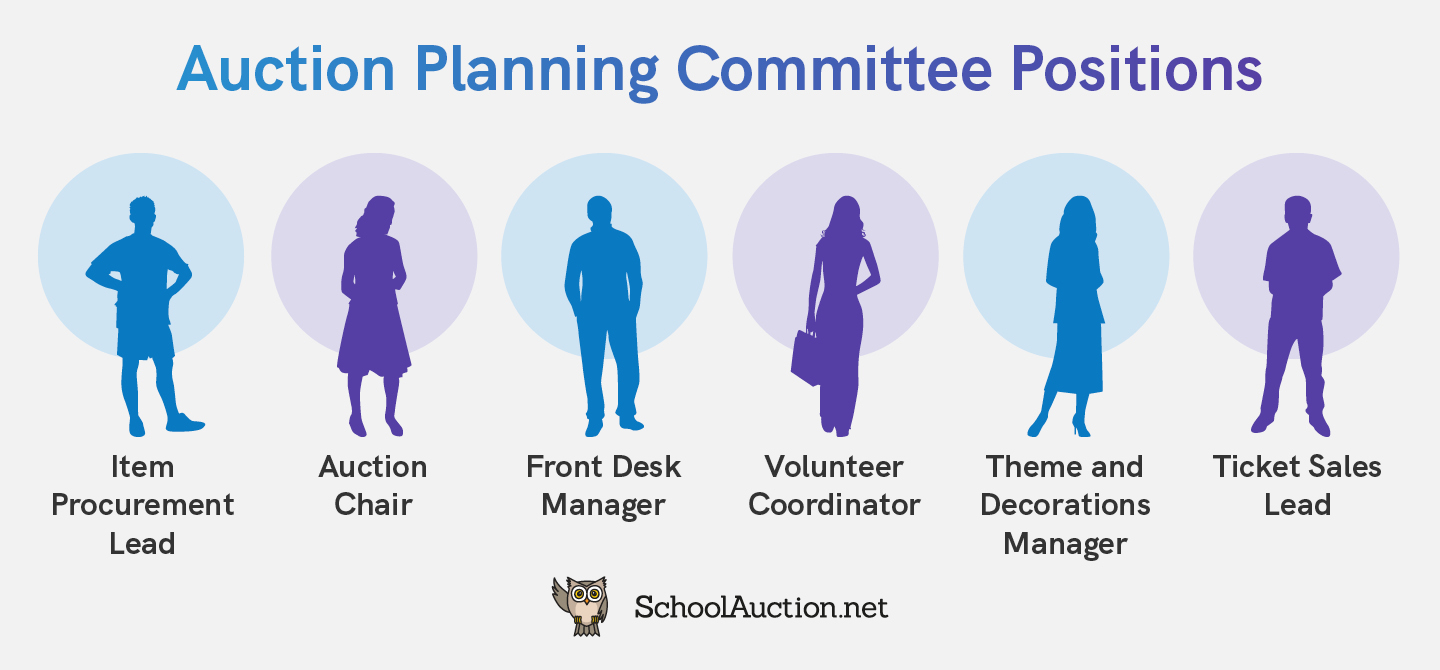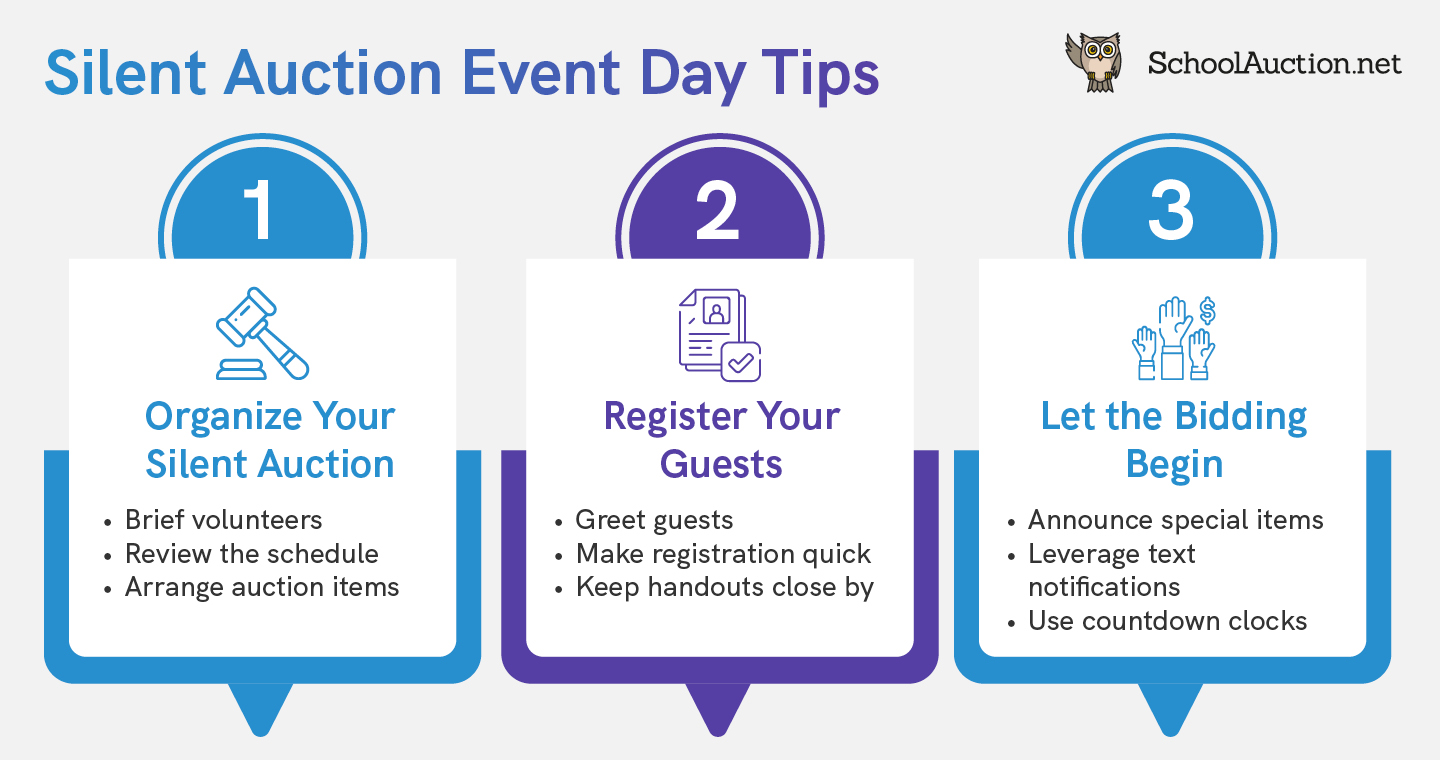Introducing the most popular auction type: the silent auction. Schools and volunteer-run organizations rely on silent auctions to generate funds to support their missions. Because silent auctions are exciting, competitive events, they have the potential to draw major crowds (and raise major funds).
In this guide, we’ll explore silent auction basics and provide tips to run an effective silent auction. Here’s an overview of our silent auction journey:
If you’re new to silent auctions, don’t be intimidated. Equipped with these tips and tricks, you’ll run your own successful silent auction in no time.
Unlock the right tools to streamline every aspect of your silent auction.
What is a silent auction?
Silent auction fundraisers are events where guests are invited to browse appealing displays of donated items and bid on them by making an offer on their corresponding paper bid sheet. More recently, silent auctions have adopted mobile bidding, letting supporters submit their bids through their phones.
Silent auction items are often gift certificates to local businesses, quality physical goods, or expertly bundled gift baskets with a range of values depending on audience preferences and the scale of the auction.
PTAs, nonprofits, animal shelters, and other volunteer-driven organizations often pair their silent auctions with other events, such as a gala. Silent auctions thrive in well-decorated venues with plenty of space to show off the procured auction items. Alternatively, you can display your catalog of items online through your mobile bidding site.
In both instances, attendees are invited to bid on items that strike their fancy and support a cause they feel passionately about.
How does a silent auction work?
Now that we’ve set the scene, you might be wondering how a silent auction functions. In comparison to a live auction, where all guests bid on the same item at the same time, silent auction bids are asynchronous, meaning that attendees bid on different items at their own pace throughout the event. Once the event is over, the highest bid wins each item.
Unlike live auctions, silent auctions do not have a designated auctioneer to mediate between bidders. Instead, attendees are free to roam the auction tables and manually or digitally record a bid for their favorite items. While attendees wander by the auction tables, an emcee welcomes new attendees, highlights various items, and announces how much time guests have left to bid.
How does an online silent auction work?
In a nutshell, online silent auctions take the same auction idea and transfer it to an online format. These auctions have become a popular trend because of the advantages associated with them, including:
- Increased bid time. Moving your silent auction online means that you can extend your auction across multiple days. That gives your auction items more time to earn more bids.
- Increased audience reach. You can reach more bidders by using a flexible online format. There’s no need for guests to travel to an in-person event (though you have the option of combining this format with an in-person auction if you wish). Instead, guests can bid no matter where in the world they’re located, at whatever time is best for their schedule.
- Cost and time efficiency. Online silent auctions don’t require additional food or venue costs. Plus, you won’t need to worry about recruiting volunteers to decorate your event space or manage guests.
If you want to host an online silent auction, you need to have the right tools to make it a success. This means investing in online auction software is a must.
Effective online silent auction software will keep your guests engaged with features like:
- Outbid and extended bidding notifications
- Customizable event pages
- User-friendly registration and check-out
- Intelligent donor and sponsor data tracking
- Branded item catalog creation capabilities complete with item descriptions and multiple photos
You can also modernize your in-person silent auction with these same auction software tools. For example, you might have your guests bid through their phones at your gala’s silent auction, letting them enjoy the rest of your event rather than sticking close to specific bidding sheets. Whether you choose to go online or in person, having a robust software platform will ensure your bidders enjoy a top-tier experience.
Create a modern, engaging auction experience with silent auction software.
How do you run a silent auction?
You’ve probably gathered that successful silent auctions require careful planning and a reliable strategy. But, how do you formulate and execute a winning strategy?
The same way you eat an elephant — by breaking down your strategy into bite-sized steps! There are three silent auction stages that can be divided into even smaller bite-sized pieces: preparation, event day, and post-auction.
Each stage has its own priorities and to-do list. And, spoiler alert, the most important stage is pre-auction planning. Without further delay, let’s eat that elephant!
Silent auction preparation tips
Arguably, the success of your silent auction depends on the details of your plan. Everything from your budget to your procured items set the stage for the big auction day.
To simplify the planning process, we’ve provided some easy-to-follow preparation steps:
1. Recruit a planning committee.
It’s time to field your silent auction dream team! Your team should help you carry out auction responsibilities from beginning to end. In a well-formed planning committee, each member will have a defined role. These positions are not limited to, but can look like:

- Item Procurement Lead
- Auction Chair
- Front Desk Manager
- Volunteer Coordinator
- Theme and Decorations Manager
- Ticket Sales Lead
After you’ve delegated responsibilities, meet as a team to ensure you’re aligned on your silent auction’s vision and objectives. Discuss items like:
- Budget constraints. A memorable silent auction requires making an investment. Agree to a fixed budget for items like venue, decor, food and drinks, auction software, and entertainment.
- Event theme. How fancy is your auction going to be? Is it a casual or black-tie event? Consider what theme will engage your audience the most.
- Venue and date. Many times, venues can inform your theme or vice versa. Think about the best location for your attendees, and choose an event date far in advance to give your team plenty of time to plan.
- Fundraising goal. Determine how much you aim to raise from core silent auction fundraising strategies such as fixed-price items, ticket sales, and donations.
- Volunteer recruitment. Find volunteers by reaching out to supporters in your local community. Or, if you’re running a school auction, partner with your high school’s honor clubs and market your silent auction as a way for students to earn volunteer hours.
These planning committee discussions will likely take place over a series of multiple meetings. Just remember the sooner you start the planning process, the easier your silent auction will be to pull off.
2. Procure your silent auction items.
Items are the main selling point for your silent auction. To stock your auction with items that will drive bids and excitement, consider your audience. Segment your attendees by age, income, interests, and hobbies. Refer to previous auction data to refine your procurement strategies.
Next, locate and reach out to potential fundraising sponsors that align with your audience’s preferences. For instance, if your audience is primarily major donors, you may focus on big-ticket items like expensive getaways. Or, if your audience is mostly families with young children, you might sprinkle in a few items that are lower-value but likely to excite kids like s’mores making supplies.
Auction items that bring in the highest bids have a reputation for being exclusive, unique, and intriguing. Here are a couple of best-sellers:
- Local experiences. Auction items that have the ability to create memories or an escape from donors’ daily routines are usually big hitters. Think through the details of your local experience packages. For instance, a date night package could include a bottle of wine, a restaurant gift card, and a certificate for free babysitting.
- Auction baskets. Take advantage of the traditional auction basket by filling it with goods and activities. If you know your audience members are fans of a particular sports team, for example, stock a basket with season tickets, sports memorabilia, and merchandise.
- Unique or rare items. For instance, you could reach out to a local artist for one-of-a-kind sculptures, framed paintings, glasswork, or prints to act as auction statement pieces.
Record and communicate the respective value of each auction item to provide context to bidders. Then, leverage your network to find new sponsors so you can make your auction item wishlist a reality.
Promote your silent auction
As the final silent auction preparation step, promote your upcoming event day! Add your event name, theme, and auction items to a customizable event site and all of your marketing materials.
Collaborate with your committee to form a marketing strategy to reach your audience. To attract as many guests as possible, try leveraging the following communication channels:
- Email updates. Notify attendees with a save-the-date email so they can mark your silent auction on their calendars. You can also promote your auction through your online newsletter.
- Social media updates. Create posts about your upcoming event and spread them on the social media platforms your audience uses the most. For example, you might use Facebook to attract a slightly older audience.
- Promotional flyers. Create paper flyers to promote your event and post them in local community areas.
- Local news and press outlets. Reach out to local press outlets for a spot to advertise your fundraising event. This might be your town’s newspaper or local radio show.
Promote your auction by highlighting your biggest auction items. Showcasing pictures of signed memorabilia or photographs from the scenic location of a getaway vacation package will increase bidder interest and suspense leading up to your event.
Congratulations! You’ve planned your event details. Now it’s time for the bidding to start.
Need some advice to get your next silent auction off the ground?
Silent auction event day tips
The long-awaited silent auction event day has arrived, and you’re ready for it. Let’s make it a memorable and enjoyable day for auction guests.
To ensure a picture-perfect experience, you’ll need to organize your auction, smoothly register guests, and facilitate seamless bidding. Let’s explore how to achieve each of these objectives.

1. Organize your silent auction.
Use your detailed plan to organize your silent auction before guests arrive. This means coming together with your auction event team to cover essential items like:
- Briefing volunteers on their responsibilities. Ensure all volunteers are briefed on how to greet, register, manage, and checkout guests. Run through the auction item pick-up sequence and give your volunteers plenty of time to ask questions before guests arrive.
- Reviewing the event schedule. If you have scheduled entertainment, consider how it will last to announce firm bidding start and end times.
- Arranging silent auction items. Post visible signage to ensure no auction items are overlooked. Space items evenly, place artwork in easels or frames, and ensure item bundles are clearly grouped together.
- Organizing silent auction items. Use ribbons or tablecloths to separate items by type so interested guests can easily find multiple prizes to bid on. Or, separate items by price categories so guests can bid and stick to their personal budgets.
If you’re using mobile bidding software, print out QR codes for each item. Guests can scan them with their phones and be taken straight to that item’s online bid sheet.
2. Register your guests.
Ask guests to check in online to keep lines moving quickly. Before guests start filing in, ensure you have a reliable system on hand to check their registration status. Here are some registration tips to consider:
- Be ready to welcome. Have volunteers ready to greet guests, and provide informational materials about your auction.
- Keep registration quick. Use your auction software’s check-in feature to pull up guests’ information quickly and prevent long lines.
- Keep handouts close by. Any bid paddles, programs, or other printed materials should be ready to give guests as they enter the venue. Or, be sure to brief guests on how to access pertinent bidding information via their mobile devices.
It’s best to conduct registration at a physical table near the entrance to the venue so guests can clearly see where to enter the silent auction. Set up your check-in tables in a location where any lines that form won’t interrupt the rest of your event. After all, having to walk around a big line to see the rest of your auction likely won’t make for the best guest experience. After most people have checked in, reference your pre-made attendee list to be sure all guests have arrived.
3. Let the bidding begin.
Facilitate a fun bidding environment to put guests in a positive mood. Don’t make your silent auction silent, to energize your event, consider:
- Having the emcee announce special items. With a room full of people and items on multiple tables, some bidders may forget about certain items. Have your emcee draw attention to high-value items or items that haven’t received many bids to get your supporters’ attention.
- Using text notifications to build suspense. Mobile bidding provides a more modern take on item announcements. With mobile bidding software, bidders can receive announcements and outbid notifications.
- Using countdown clocks to add excitement and encourage competition. Make bidding a race against the clock. Set up a large clock for bidders to reference while they peruse auction items.
The countdown timer has buzzed to signal that bidding has come to a close. Now it’s time to organize the final stage of your silent auction.
Post-silent auction tips
Now that the highest bidders have secured their items, don’t make them wait too long to exit the auction venue. Instead, end your silent auction on a high note by implementing a seamless checkout process.
1. Streamline guest checkout.
Even if auction attendees win their dream item, a hectic checkout process will put a damper on their experience. Try these tested methods to keep supporters coming back for your next auction:
- Let your guests check themselves out from their phones. Some guests will still need assistance, but get the bulk of your audience on their way quickly with self-check-out.
- Use payment processing systems to accept different payment types. Cash payments are a dying breed, so have credit and debit processing at the ready.
- Set up physical checkout booths based on payment type. For the few guests who don’t want to or can’t use your self-check-out system, it’s convenient to have a physical booth ready to process cash or checks.
- Closeout payments with necessary hardware. Use a computer and a card reader to close out guest payments.
Next, direct guests to a designated auction item pick-up station where they’ll use their winning bid number to receive their items.
2. Hand out auction items.
Unclaimed items are a big issue for many silent auctions. Prevent this from happening at your auction by:
- Using auction software to identify pre-tracked winners. Or, if you’re going old-fashioned, manually record the auction winner’s name and bid amount.
- Assembling items for pick-up in a separate booth. Instruct volunteers to move items to a separate location close to the checkout area for winner pick-up.
- Confirming winning bidder numbers. Deliver items to the winning bidder numbers. Once the winning bidder has picked up their item, mark it as “CLAIMED” on the winning bid sheet.
Give your team a high-five! All auction guests have claimed their items, and you just pulled off a stellar silent auction like it was nothing. All that’s left is to thank everyone for contributing to an amazing event.
3. Thank donors, attendees, and staff.
Show your appreciation for the people who helped you pull off your silent auction. Thank sponsors in a thoughtful and timely manner. Send them a card in the mail or give them a call to thank them personally.
Additionally, write personalized thank you letters to attendees. Include a fundraising update to demonstrate the impact of their gifts. However, avoid asking for any monetary requests at this time. Later on, you can reach out to promote other events or ask for gifts, but your initial follow-up is ultimately a time for appreciation.
Finally, thank your auction team. Committee members, staff, and volunteers are the behind-the-scenes folks that stood with you throughout the process.
Wrapping up: Maximizing your silent auction success
We’ve taken you through each stage of the silent auction process: preparation, event day, and post-auction. Now it’s your turn to follow this guide and host your organization’s best silent auction to date!
To prepare for future auctions, we recommend reconciling your budget, expenses, and revenue and creating a detailed report. Use metrics like the amount raised and projected goal, attendee count, items sold, and bidding amounts to summarize event success. That way, when auction season comes around again, your team will be ready.
To your silent auction success!




